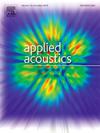Sound absorption in uniform and layered gyroid and diamond triply periodic minimal surface porous absorbers
IF 3.4
2区 物理与天体物理
Q1 ACOUSTICS
引用次数: 0
Abstract
We investigate the acoustical properties of additively manufactured porous absorbers with gyroid and diamond triply periodic minimal surface pore geometries. Porous samples with different relative densities are fabricated using vat photopolymerization and tested using acoustic impedance and airflow resistivity measurement setups. Optical microscopy shows that the increased wall thicknesses due to polymer expansion causes the actual relative densities of the fabricated samples to exceed the intended designs. The two-microphone tests demonstrate that higher relative densities enhance sound absorption effectiveness, with the diamond geometry outperforming the gyroid at equivalent relative densities. The airflow resistivity tests indicate that the superior performance of the diamond samples stems from their increased airflow resistance, attributable to the absence of through-holes in their structure. We use the inverse characterization approach to model the absorbers using the Johnson-Champoux-Allard rigid formulation, uncovering additional variations in bulk transport properties that are linked to the differing geometries. The validated numerical models are then used to predict the sound absorption performance of sound package designs with various series and parallel relative density gradients using a transfer matrix method. Our results show that such layered configurations of additively manufactured TPMS-based absorbers can enable the design of sound packages with application-specific absorption performance.

均匀层状陀螺和金刚石三周期最小表面多孔吸声器的吸声特性
我们研究了具有三周期最小表面孔隙几何形状的螺旋形和金刚石增材制造多孔吸收器的声学特性。采用还原光聚合法制备了不同相对密度的多孔样品,并利用声阻抗和气流电阻率测量装置进行了测试。光学显微镜显示,由于聚合物膨胀而增加的壁厚导致制造样品的实际相对密度超过预期的设计。双传声器测试表明,较高的相对密度提高了吸声效果,在同等相对密度下,金刚石几何形状的吸声效果优于陀螺仪。气流电阻率测试表明,金刚石样品的优异性能源于其结构中没有通孔而增加的气流阻力。我们使用逆表征方法使用Johnson-Champoux-Allard刚性公式对吸收剂进行建模,揭示了与不同几何形状相关的体积传输特性的其他变化。利用验证的数值模型,利用传递矩阵法对具有不同串并联相对密度梯度的声包吸声性能进行了预测。我们的研究结果表明,这种分层结构的增材制造的基于tpms的吸声器可以设计出具有特定应用吸收性能的声音封装。
本文章由计算机程序翻译,如有差异,请以英文原文为准。
求助全文
约1分钟内获得全文
求助全文
来源期刊

Applied Acoustics
物理-声学
CiteScore
7.40
自引率
11.80%
发文量
618
审稿时长
7.5 months
期刊介绍:
Since its launch in 1968, Applied Acoustics has been publishing high quality research papers providing state-of-the-art coverage of research findings for engineers and scientists involved in applications of acoustics in the widest sense.
Applied Acoustics looks not only at recent developments in the understanding of acoustics but also at ways of exploiting that understanding. The Journal aims to encourage the exchange of practical experience through publication and in so doing creates a fund of technological information that can be used for solving related problems. The presentation of information in graphical or tabular form is especially encouraged. If a report of a mathematical development is a necessary part of a paper it is important to ensure that it is there only as an integral part of a practical solution to a problem and is supported by data. Applied Acoustics encourages the exchange of practical experience in the following ways: • Complete Papers • Short Technical Notes • Review Articles; and thereby provides a wealth of technological information that can be used to solve related problems.
Manuscripts that address all fields of applications of acoustics ranging from medicine and NDT to the environment and buildings are welcome.
 求助内容:
求助内容: 应助结果提醒方式:
应助结果提醒方式:


